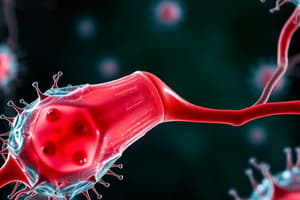Podcast
Questions and Answers
What are the two main parts of the adrenal gland?
What are the two main parts of the adrenal gland?
The two main parts of the adrenal gland are the cortex and the medulla.
What are the three types of steroid hormones produced by the adrenal cortex?
What are the three types of steroid hormones produced by the adrenal cortex?
The three types of steroid hormones produced by the adrenal cortex are glucocorticoids, mineralocorticoids, and androgens.
What is the function of the adrenal medulla?
What is the function of the adrenal medulla?
The adrenal medulla produces catecholamines, such as adrenaline and noradrenaline.
What is the enzyme responsible for the interconversion of cortisol and cortisone?
What is the enzyme responsible for the interconversion of cortisol and cortisone?
What is the site of synthesis for cortisol? How is cortisol regulated? How does stress influence cortisol secretion?
What is the site of synthesis for cortisol? How is cortisol regulated? How does stress influence cortisol secretion?
How would you investigate a subject suspected of having Addison's disease? What are some metabolic manifestations of Addison's disease?
How would you investigate a subject suspected of having Addison's disease? What are some metabolic manifestations of Addison's disease?
How would you investigate a subject suspected of having Cushing's disease? What are some metabolic manifestations of Cushing's disease?
How would you investigate a subject suspected of having Cushing's disease? What are some metabolic manifestations of Cushing's disease?
What are the two types of solid phases/chemistries mentioned in the text?
What are the two types of solid phases/chemistries mentioned in the text?
What is the recommended technique for measuring the ACTH Circadian rhythm?
What is the recommended technique for measuring the ACTH Circadian rhythm?
What are the three fractions that steroid hormones are bound to?
What are the three fractions that steroid hormones are bound to?
How do unbound steroid hormones regulate gene transcription?
How do unbound steroid hormones regulate gene transcription?
What is the role of aldosterone in the regulation of sodium and electrolyte balance?
What is the role of aldosterone in the regulation of sodium and electrolyte balance?
What are the manifestations of hypocortisolism?
What are the manifestations of hypocortisolism?
What is the purpose of the Synacthen stimulation test?
What is the purpose of the Synacthen stimulation test?
What are the causes of hypocortisolism?
What are the causes of hypocortisolism?
What is the primary cause of hypercortisolism?
What is the primary cause of hypercortisolism?
What are the manifestations of Cushing's Syndrome?
What are the manifestations of Cushing's Syndrome?
What is the purpose of a dexamethasone suppression test?
What is the purpose of a dexamethasone suppression test?
What is the normal result of a low dose overnight dexamethasone suppression test?
What is the normal result of a low dose overnight dexamethasone suppression test?
What is the role of glucocorticoids in the transcription of IL6 gene?
What is the role of glucocorticoids in the transcription of IL6 gene?
How are steroid hormones metabolized and excreted in the body?
How are steroid hormones metabolized and excreted in the body?
What is the process of turning off the signal and downregulating hormone action?
What is the process of turning off the signal and downregulating hormone action?
What are the reference intervals for salivary cortisol in adults in the morning, afternoon, and evening?
What are the reference intervals for salivary cortisol in adults in the morning, afternoon, and evening?
What are the reference intervals for salivary cortisol in neonatal babies in the morning and babies up to 6 months old in the morning?
What are the reference intervals for salivary cortisol in neonatal babies in the morning and babies up to 6 months old in the morning?
What are the reference intervals for salivary cortisol in children aged 2-6 years in the morning and afternoon?
What are the reference intervals for salivary cortisol in children aged 2-6 years in the morning and afternoon?
What are the reference intervals for salivary cortisol in children aged 6-11 years in the morning and afternoon?
What are the reference intervals for salivary cortisol in children aged 6-11 years in the morning and afternoon?
Flashcards are hidden until you start studying




